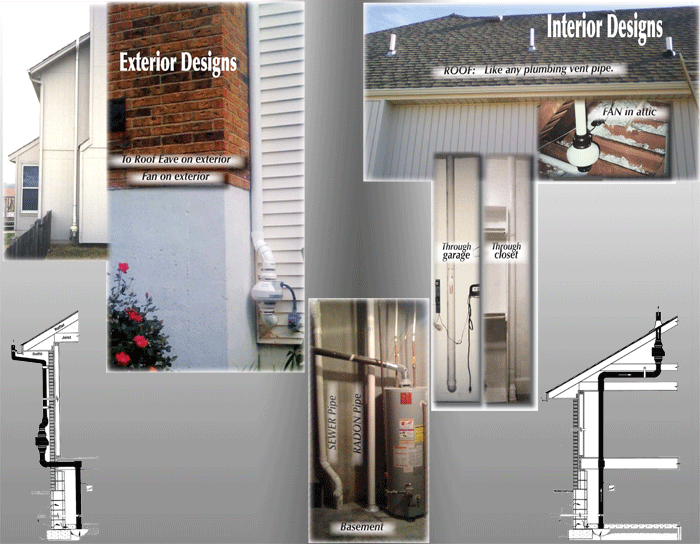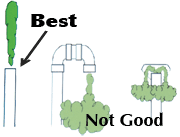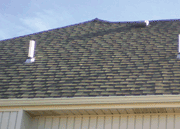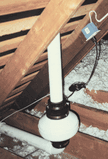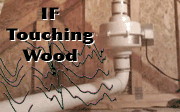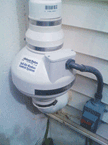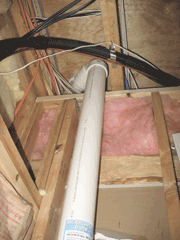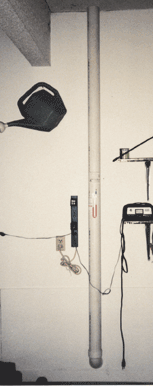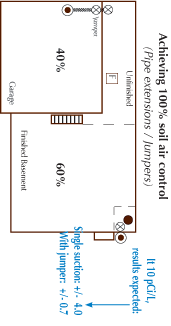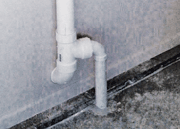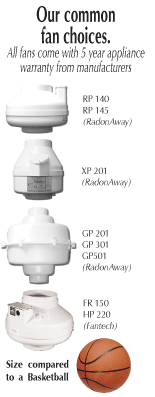TOP TO BOTTOM
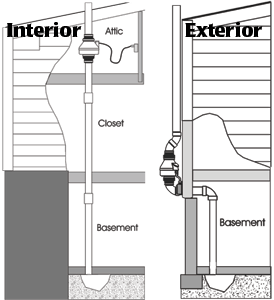
|
DISCHARGE
ROOF
EAVE
ATTIC
NOISE
ELECTRICITY
PIPE RUNS
SEALING
SUCTION PITS
SUCTION LOCATIONS
CRAWL SPACES
FANS
ENERGY EFFICIENCY
STANDARDS
MAINTENANCE
ACTION LEVELS: 4.0, 2.7, 2.0 pCi/L |
|
DISCHARGE (at the top)
OPEN - BLOWING FREELY AWAY FROM THE HOME - NO RAIN CAPS:
Systems and fans must to be installed fully capable of letting water pass through the system and drop to the soil under the home. Each day, more water condensates withing piping and drains to the soil than a whole year of rain that could enter the discharge.
The air discharged is typically near 100% relative humidity. Ice and condensate will form on objects the air strikes. Ice can shut down systems with blockage and siding can rot with constant wetness.
LOCATIONS: High on the home (or at least 10 feet above grade). Requirements resemble those for sewer gas or chimney vents to help assure polutants do not enter the home through windows or other openings into living space. Discharge must be at least 2 feet above or 10 feet to the side of any operable window or opening into occupied spaces of the home.
|
|
ROOF (at the top)
No different in appearance or rain protection than any other plumbing vent on the roof. Discharge must still be at least 2 feet above or 10 feet to the side of any operable window or opening into occupied spaces of the home. |
|
EAVE (at the top)
To “discharge above the eave”. The standard published as EPA-RMS (1994) is still employed in most areas of our country. It has always been widely interpreted for this requirement to be “above a roof eave anywhere on the home”. This interpretion does not mean above the eave in the specific pipe location. It allowed some freedom for other design and cosmetic considerations.
The AARST ASD-RMS indicates above the roof line. ASTM E2121 is similar. All standards recommend the best consideration is for above the highest point of the roof and the state of Illinois made this a requirement. Still, they must grant variances to this requirement since it is commonly difficult to cosmetically achieve.
Regardless: Discharge must still be at least 2 feet above or 10 feet to the side of any operable window or opening into occupied spaces of the home.
|
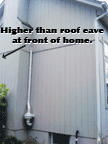
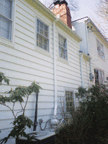
|
ATTIC (at the top)
NOISE: Fan and piping must be routed to not touch wood framing in a fashion to minimize transfer of vibrations to wood framing.
ELECTRICITY: An outlet (or disconnect) should be within 6 feet of the fan. It should not be on a switched circuit. The low energy needs (less than 1 amp or 30-80 watts) allow connection to most light or outlet branch circuits.
|
|
NOISE
Fan and piping must be routed to not touch wood framing in a fashion to minimize transfer of vibrations to wood framing. It is seldom the fan that causes noise unless failing.
|
|
ELECTRICITY
The low energy needs (less than 1 amp or 30-80 watts) allow connection to most light or outlet branch circuits.
ATTIC LOCATIONS: An outlet (or disconnect) should be within 6 feet of the fan. It should not be on a switched circuit. Cords are commonly used and must not be longer than 6 feet.
EXTERIOR LOCATIONS: A switch or other form of disconnect should be within eyesight of the fan. Wiring should be protected by sturdy conduit and all parts and systems rated for exterior use. |
|
PIPE RUNS
MUST DRAIN: Pipes must be able to drain water (from significant condensation within piping and other sources). Pipes must be glued and sealed.
PIPE SIZE: The piping must be capable of moving the needed volume of air to establish a vacuum under the home. This is much like sizing of heating ducts to insure enough heated air can be delivered to a room so that an occupant is not cold.
Typically, 3 inch piping moves enough air for most homes yet some require 4" piping. This is a function of size and leakage for the cavity of air under the home being addressed.
2" piping has been often seen to not allow enough air volume to address most homes. 6" piping may be appropriate for large spaces such as the cavity under a school gymnasium.
ELBOWS and PIPE LENGTH: Pipes can make many turns and run long distances for accomplishing reasonale installations. Fan powered systems are fine so long as they don't add up to airflow restrictions that are more than the needed volume of air required to establish the vacuum under the slab.
Long horizontal runs should be minimized, when practical, because of the chance that building settlement and other factors can cause stress on joints and strapping. These can result in leakage or changes in pipe pitch needed for draining water.
Passive systems (i.e. new construction) require attentiveness for elbows and pipe length if success is to be expected from passive systems. These systems rely upon heat convection long pipe run and wind effect at the exit pipe to cause breathing of soil air to the outside.
PRESSURED SIDE PIPE: All components after the fan must be outside of heated and cooled spaces. Pressure side piping blows air out and any leak or break in piping can introduce potent radon into the home.
PIPES THROUGH WALLS AND CEILINGS: Pipes can routinely pass through finished walls and ceilings with tight hole fitting to allow reasonable cosmetics. Concerns only relate when a pipe might compormize the structural integrity of a joist or other component.
CODES: The intent of remodeling codes is that building components shall not be left in a worse condition than found before the work is performed.
THROUGH JOISTS: Pipe routes can go through wood members but in a manner that does not compromize the structural integrity of joists or wood members.
FIRE RATED ASSEMBLIES: Pipe routes can go through fire walls but in a manner that does not compromize a fire rated assembly. An assembly refers to the fact that all walls and ceilings must be constructed in a manner that slows fire and smoke from spreading out of that area (i.e. garage). Such a fire rated assembly does not exist in many homes. When appropriate, fire collars at penetrations through a rated assembly can be mounted to maintain the integrity of a fire rated assmbly.
|
|
SEALING
Sealing of accessible openings to soil is typically a needed system component. A mostly closed barrier between soil and living spaces is needed for effectiveness in creating a slight vacuum under the home.
Still, a substantial leakage area will exist undetectable to the eye regardless of meticulous efforts. New settlement cracks in concrete also form over the years. (Systems are still effective since soil air is pulled away from living spaces.)
Item & Materials
Sump cover: . . . . . . . Customized from clear, non-breakable plastic.
Accessible floor-wall joint: Urethane caulking.
Tiny “hair line” cracks: Typically not cost effective or meaningful.
Misc. cracks & openings: Caulk, expanding foam, mortar (as needed).
Drains: . . . . . . . . . . . . Air Traps. (a float prevents upward air flow.)
Open Earth: . . . . . . . . Poly sheeting placed over open earth and secured/sealed to walls.
DISCUSSION OF SEALING ALONE: .... “EPA does not recommend the use of sealing alone to reduce radon because, by itself, sealing has not been shown to lower radon levels significantly or consistently.” Always unpredictable, sealing alone may sometimes reduce levels 10-50%. However, often little effect is seen (even if all gaps and openings are accessible to seal).
|
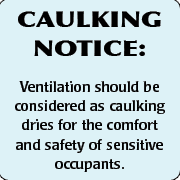
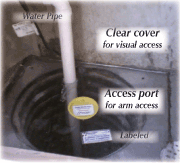
|
SUCTION PITS
SUCTION TO GRAVEL: Homes built since the 1960s in our region will typically havea gravel bed under the concrete slabs. This was placed for enhanced water drainage but represents a hollow space for air movement.
SUCTION TO TIGHT SOIL, SAND, CLAY, ETC.: Homes built before the 1960s in our area will typically have slabs poured directly onto soil. In rural areas, sand was also commonly used under slabs. Such conditions require digging a pit under the suction point to maximize available gaps between soil/sand granules for increased airflow. This extends the distance from the suction point of soil air control.
SUMP SUCTION? Best avoided.
Obstructs access to pump for repair or emergencies.
For homes built before the 1960s in our area with slabs poured directly onto soil or homes built with sand or compacted soil under the slab: Sump Suction may be the best option to extend soil air control.
NOTE: Rubber coupling REQUIRED on the suction pipe to provide at least some easier acess for removing cover.
Often existing covers "sealed in place" are essentially glued heavily. One must SAW OFF the cover to check or replace pump.
A flooding basement is an urgent event.
Experienced care can help prevent problems.
RESPONSIBLE SUMP COVERS
• Visual access to conditions in pit
• Removable plug for arm access
• Anchored and sealed air tight
• Labeled
• Can hold the weight of an adult
|
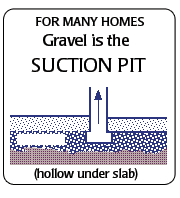
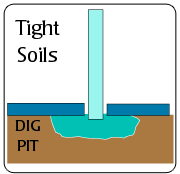
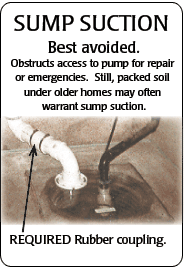

And avoid Obstructed Access
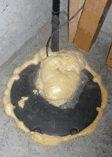
|
SUCTION LOCATIONS
FOR GRAVEL: Locations can be anywhere in the slab. Since it is hollow underneath, location does not matter for effectiveness.
FOR SOIL, SAND, CLAY: Extension of sub-slab vacuum is the challenge. Hollow gaps near the edge, locations that might best achieve exterior draintile vacuum extension or sumps with draintile extensions.
SEE SUCTION PITS FOR MORE DETAIL
AND MULTIPLE SLABS
ADDRESSING THE WHOLE BUILDING: Radon enters from under all areas with potency usually based upon area size.
When practical, seeking 100% control of the home's footprint for soil contact will serve to maximize reductions.
|
|
CRAWL SPACES
SUBMEMBRANE DEPRESSURIZATION: Suction to under plastic sheeting. Poly sheeting placed over open earth and secured/sealed to walls.
INACCESSIBLE CRAWL SPACES: When access is not available into the crawlspace, it might be best to not treat this area, if possible, or the air space might be treated with Crawl Suction.
CRAWL VENTS; Vents allow air dilution within the crawl yet sometimes do not prevent radon movement upwards and vents are often closed in hot and cold weather for energy considerations. They might not be viewed as permanent solutions and if made permanent, open vents can cause frozen pipe damage if care is not taken to insulate water pipes, etc.
CRAWL SUCTION: The exterior openings to the crawl are sealed and vacuum is applied to the entire crawlspace. This method should be avoided when possible. Future openings in the shell of this airspace might inadvertently occur without an occupant knowing. Vapor in the crawlspace is also enhanced. |
|
FANS
If installed properly:
Systems should maintain effectiveness for as long as the fan is kept running.
The fans move less air than many bathroom fans (typically less than 60 CFM). Continuous operation is required yet inexpensive (similar to a 40-80 watt light bulb).
Fans are designed to allow rain and all other water to pass through to the soil. Rain caps on pipe are not recommended.
Choices: Experience in choosing the best fan is important. It is a balance between vacuum pressure needed (based upon sub-slab conditions) and air volume needed (based upon cavity sizes and tightness.
Bigger is not better yet too small will result in compromised effectiveness in cold weather. Oversized fans can cause noise, excess energy loss and problems with other building systems such as combustion appliances. Light duty fans require situations where all gaps and openings to soil can be sealed.
Noise: Most often noise problems are not from the fan but caused by things the fan or piping touch. Piping must be installed to avoid vibration transfer to wood framing.
For older homes or any built upon tight soil or sand, high suction fans may be required and are capable of greater vibration. Choosing a smart location for the fan becomes important.
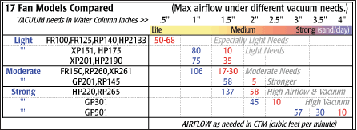
|
|
ENERGY EFFICIENCY
Fans: Continuous operation is required yet inexpensive (similar to a 40-80 watt light bulb). This may equate to a yearly expense of $40-140 is electricity depending upon the fan and local energy costs.
Air leakage from the home: There is a minor energy penalty when air is pulled out of the home but major renovations to seal small cracks are not justified monetarily. The energy loss occurs because air drawn into the system from the occupied spaces will cause a slight amount of extra air to enter the home from outside. The extra outside air is then heated/cooled at a price (roughly $20 - $200 a year depending upon the home). Homes with mostly closed slabs and easy airflow under the home will be on the lower end of this curve.
ENERGY EFFICIENT SYSTEMS: Maximized energy efficiency requires two components: 1) Easy airflow under the home, and 2) The ability to tightly seal the cavity under the home.
With these conditions and extra care for design and sealing: Both fan energy and energy loss from heating/cooling maximizes all aspects of energy efficiency. The entire system energy cost might be less than $40 a year.
|
|
STANDARDS
Systems must comply with national standards: EPA-RMS (1994), AARST ASD-RMS (2006) and/or ASTM E2121 (2001-2008).
These standards lay out requirements for locations of discharge and fans while also covering details of pipe runs, sealing and more. |
EPA
AARST
ASTM |
MAINTENANCE
ROUTINELY CHECK THAT FAN IS OPERATING. Because fans are so quiet, a pressure gauge is required on the piping for easy verification that the fan is operating.
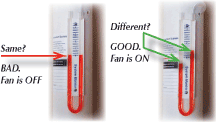
If Fan Failure is indicated:
• Check that electrical power is on which may include switches, breakers, GFCI breakers or other wiring.
• Check that the small hose at the top of the gauge is connected and not crimped or fowled with debris.
• Contact our office if it then appears service is needed.
Fan failure is not an urgent situation. Ensure repairs soon yet the concern for radon is long term exposure.
The gauge is only an ON/OFF indicator.
The gauge is NOT A RADON MONITOR.
|
RETEST: After installation, insure a retest with a continuous monitor is performed where hourly readings can help identify problems.
Thereafter: You may test for verification at any time. The USEPA recommends retesting every two years to insure continued effectiveness. Home test kits are an inexpensive and effective test for this purpose.
 |
RADON ACTION LEVELS: 4.0, 2.7, 2.0 pCi.L
4.0 pCi/L Achieving below the USEPA action level of 4.0 pCi/L can be accomplished for virtually any home. Older homes can present challenges due to construction practices when they were built and in special cases it can become a question of expense versus benefit.
2.7 pCi/L The World Health Organization (WHO) has recently modified their recommended action level from about 5.3 pCi/L to about 2.7 pCi/L. This reflects recommendations regarding life-long, direct exposure. The change reflects recent population studies for statistical evidence of radon induced lung cancer.
2.0 pCi/L The USEPA recommends to consider action between 2 and 4 pCi/L since no exposure is safe. However, around about 2.0 pCi/L and lower, the lower limits of sensitivity for test devices has been reached and errors up to 300% have been seen to occur. Hence, verifying less than 2.0 pCi/L is not truly feasible (though some contractors knowingly or unknowingly make such claims or warranties).
0.7 pCi/L Outside air anywhere on earth. This is so low that even the best equipment scientists use can only estimate between 0.4 to 0.8 pCi/L. |
|
 |



